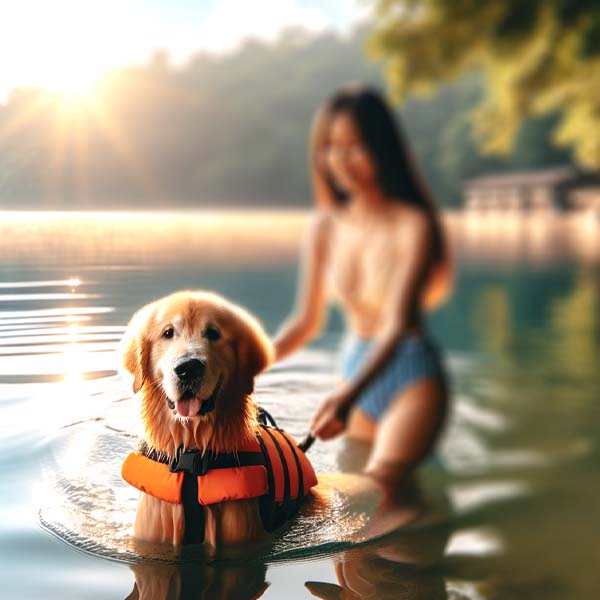
Table of Contents
ToggleHow to Teach Your Dog to Swim Safely: Step-by-Step Guide
Teaching your dog to swim can be a fun experience for both of you. While some dogs seem to enjoy water naturally, others may need encouragement. Not all dogs are natural swimmers, so patience and praise are essential for success.
Understanding Your Dog’s Comfort with Water
Before starting, consider how your dog feels about water. Some breeds, like Labrador Retrievers, are known for their love of swimming. They have features like webbed paws and water-resistant coats that help them in the water.
On the other hand, some dogs may be hesitant or even scared. Breeds with short noses, like Bulldogs, or those with heavy builds may find swimming more challenging.
Breeds That Often Enjoy Swimming
Certain breeds are well-suited for swimming. Labrador Retrievers, for example, were originally bred for water-related tasks like retrieving items. Their strong tails, webbed paws, and thick coats make them great swimmers.
Newfoundlands are another example. These dogs have been used for water rescues, thanks to their large size, webbed feet, and strong swimming ability.
Even if your dog’s breed is known for swimming, remember that every dog is different. Personality, past experiences, and confidence levels all play a role.
Signs Your Dog Might Be Nervous About Water
If your dog is uncomfortable with water, they may show signs like backing away, whining, trembling, or panting. Pay attention to their body language and avoid forcing them into the water.
Instead, help your dog feel safe. Let them explore shallow water on their own, and use treats or toys to make the experience enjoyable.
Getting Ready to Teach Your Dog to Swim
Preparation is key for a safe and positive experience. Before starting, gather the following:
- A well-fitted dog life jacket
- Fresh water
- Towels for drying off
- High-value treats
Choose a calm, shallow area with easy entry and exit points. Avoid places with strong currents or sudden drop-offs.
Essential Gear for Safe Swimming
A life jacket designed for dogs is a must. It should fit comfortably, allowing your dog to move easily while providing support in the water.
Bring a leash for control if needed, and pack towels for drying off afterward. If you’re outside in the sun, use dog-safe sunscreen on areas like the nose, ears, and belly.
Creating Positive Water Experiences
Start by letting your dog explore shallow water at their own pace. Let them sniff and touch the water with their paws while offering praise and treats.
As they get comfortable, gradually move into deeper water. Keep the experience fun and reward their progress with toys or snacks.
Step-by-Step Guide to Teaching Your Dog to Swim
Step 1: Introduce Water Slowly
Choose a calm area like a shallow pond or beach. Let your dog approach the water on their terms, without any pressure. Gradually walk into the water together, encouraging them with a cheerful voice.
Step 2: Use Toys and Treats
Toys and treats can help make swimming enjoyable. Toss a floating toy or treat into shallow water to encourage them to paddle. Reward their efforts with praise and snacks.
Step 3: Provide Support
Place a hand under their belly for added support when they’re starting to swim. This helps them stay afloat and feel secure.
Step 4: Move to Deeper Water Gradually
Once your dog is comfortable in shallow water, you can slowly introduce deeper areas. Use a leash if needed, and make sure they feel safe.
Step 5: Build Stamina
Start with short swimming sessions and gradually increase the duration as they get stronger. Incorporate toys and games to keep it fun.
Safety Tips
Always watch your dog while they’re in the water, even if they’re experienced. Check for potential hazards like strong currents or debris, and keep swimming sessions short in cold water.
Recognizing Signs of Fatigue
Signs of tiredness include lagging behind, struggling to paddle, or showing less enthusiasm. If you notice these signs, end the session and let your dog rest.
Frequently Asked Questions
What if my dog is afraid of water?
If your dog exhibits a fear of water, don’t worry! With patience and positive reinforcement, you can help them overcome their apprehension. Create positive experiences by associating water with treats, toys, and lots of praise in a controlled environment.
How long does it take to teach a dog to swim?
The time it takes to teach a dog to swim varies depending on the breed, their comfort level in the water, and the consistency of practice. With patience, positive reinforcement, and a tailored approach, most dogs can learn to swim.
Can all dog breeds learn to swim?
While some breeds are natural swimmers, most dogs can learn to swim with proper instruction and support. Some breeds might require extra assistance, like a well-fitted flotation device, to help them stay afloat and build confidence.
Is it ever too late to teach an old dog to swim?
It’s never too late to teach an older dog to swim! While puppies are often more adaptable, older dogs can still learn new skills with patience, positive reinforcement, and a gentle approach. Start with shallower water and provide plenty of encouragement.
How can I ensure my dog stays safe while swimming?
Always supervise your dog in or near water, even if they are strong swimmers, and equip them with a well-fitted life jacket. Avoid strong currents, be mindful of water temperature, and consult your vet if your dog has any health concerns.
Conclusion
Teaching your dog to swim is a rewarding activity that strengthens your bond. With preparation, patience, and plenty of encouragement, your dog can learn to enjoy the water safely. Grab your gear and head to a dog-friendly spot to create lasting memories with your furry friend!




